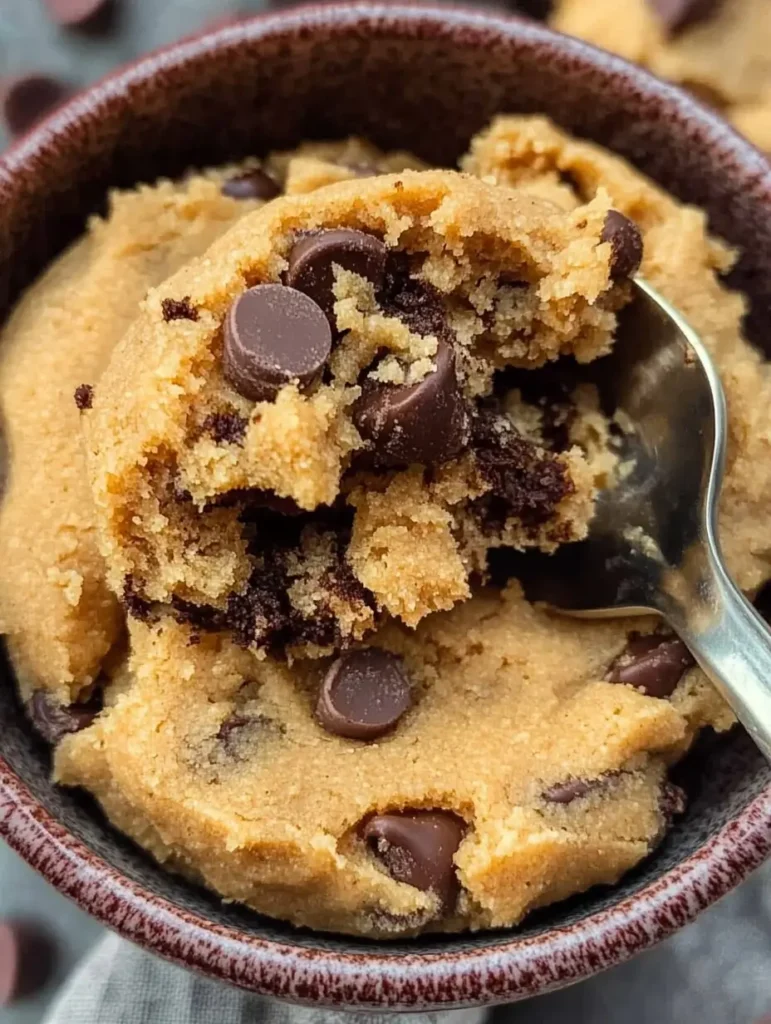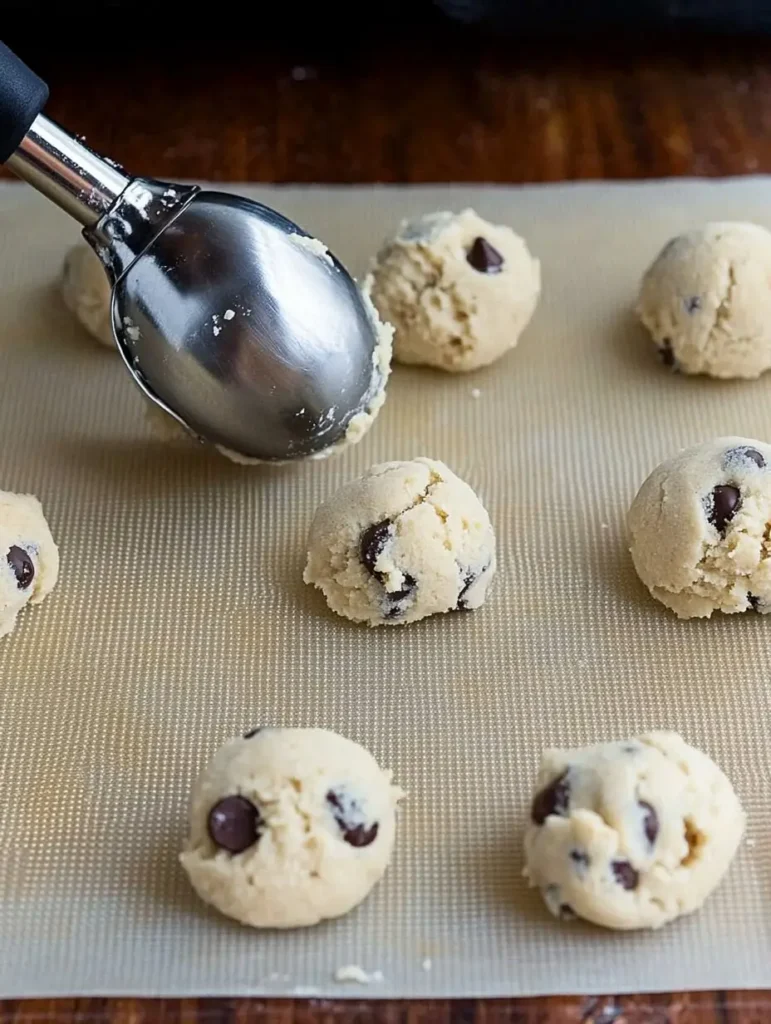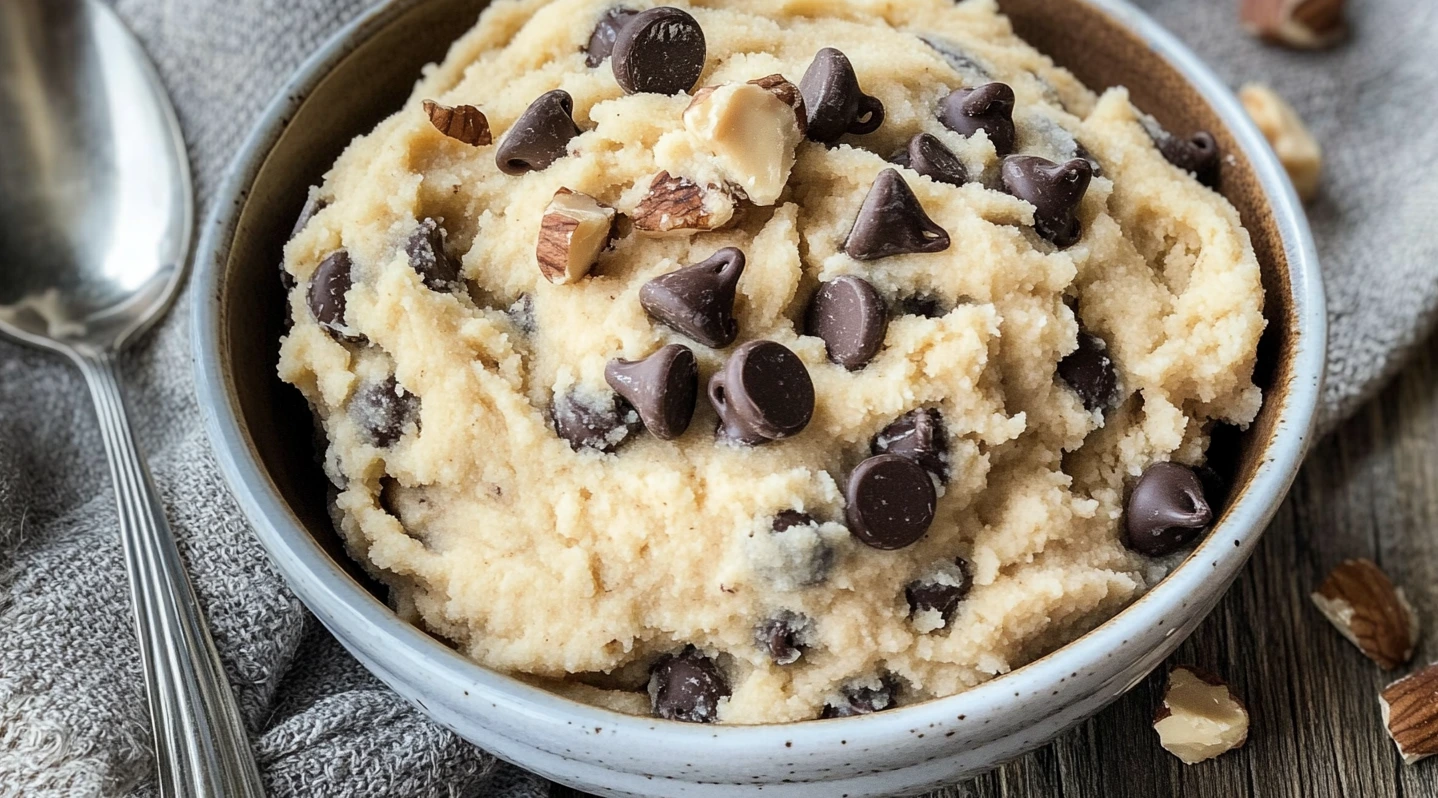Why Protein Cookie Dough?
Protein cookie dough isn’t just a health fad; it’s a game-changer. Traditional cookie dough, though irresistibly tasty, is often loaded with unhealthy fats, refined sugars, and raw ingredients that aren’t safe to eat. Protein cookie dough flips the script, replacing unhealthy components with clean, nutrient-dense alternatives while keeping the flavor intact.
- Boost Your Protein Intake: With protein powder as a primary ingredient, this treat helps build and repair muscles.
- A Healthier Dessert: Swapping sugar with natural sweeteners and refined flour with almond or oat flour keeps it wholesome.
- Quick and Easy: No baking required—just mix and enjoy.
This guide will take you through everything you need to know about protein cookie dough, from its benefits to must-try recipes and expert tips for customization.
The Benefits of Protein Cookie Dough
Protein cookie dough isn’t just a fun snack; it’s a versatile and nutritious addition to your diet. Whether you’re into fitness, looking to eat healthier, or just craving something sweet, this treat delivers on all fronts. Let’s dive into why it’s worth incorporating into your routine.
Table of contents
- Why Protein Cookie Dough?
- What Makes Protein Cookie Dough Healthy?
- Perfect for Fitness Goals
- Kid-Friendly and Safe to Eat
- Suitable for Special Diets
- Delicious Protein Cookie Dough Recipes
- Recipe Summary
- How to Customize Your Protein Cookie Dough
- FAQs About Protein Cookie Dough
- Conclusion: Why You Should Try Protein Cookie Dough
What Makes Protein Cookie Dough Healthy?
Protein cookie dough is crafted with health-conscious ingredients that offer both nutritional benefits and indulgent flavors. Here’s what sets it apart:
High Protein Content
- Most recipes include protein powder, which significantly boosts protein intake. Protein is essential for muscle repair, growth, and overall health.
- Depending on the recipe, you can get anywhere from 10-20 grams of protein per serving.
Low Sugar Options
- Traditional cookie dough is often loaded with refined sugars. In contrast, protein cookie dough uses natural sweeteners like:
- Honey
- Maple syrup
- Stevia or monk fruit sweetener for sugar-free alternatives
Clean Ingredients
- Commonly used ingredients include almond flour, oat flour, or coconut flour, which are high in fiber and lower in carbs than white flour.
- Nut butters, such as almond or peanut butter, add healthy fats and richness.

Perfect for Fitness Goals
Protein cookie dough aligns perfectly with various fitness goals, making it a favorite among athletes and health enthusiasts.
Pre-Workout Energy Boost
- The combination of healthy carbs, fats, and protein provides a steady energy release to fuel your workouts.
Post-Workout Recovery
- Protein is crucial after exercise to repair muscle tissue and promote growth. Protein cookie dough delivers the right amount of nutrients without feeling heavy.
Weight Management
- With its satiating ingredients, this snack curbs hunger and keeps you full longer. Healthy fats from nuts and fiber-rich flours stabilize blood sugar levels, reducing cravings.
Kid-Friendly and Safe to Eat
One of the biggest concerns with traditional cookie dough is the raw eggs and raw flour, which can pose health risks. Protein cookie dough eliminates these risks:
- No Raw Eggs: Recipes use nut butters, milk alternatives, or even applesauce for moisture.
- Safe Flours: Ingredients like almond flour and oat flour are heat-treated or safe to eat raw.
Plus, it’s a great way to sneak some extra protein into your kids’ diets without them noticing!
Suitable for Special Diets
Protein cookie dough can be easily customized to suit various dietary preferences and restrictions:
- Vegan: Use plant-based protein powders and dairy-free ingredients.
- Gluten-Free: Choose almond flour, coconut flour, or certified gluten-free oat flour.
- Low-Carb or Keto: Opt for unsweetened nut butters and sugar-free sweeteners like erythritol or monk fruit.
Visualizing the Benefits
Image Suggestion:
A side-by-side comparison of traditional cookie dough and protein cookie dough, highlighting the differences in ingredients like almond flour, dark chocolate chips, and protein powder.
Protein cookie dough proves that you don’t need to compromise on taste to eat healthily. In the next section, we’ll explore the key ingredients that make up this delicious snack and how to choose the best options for your recipes.
Key Ingredients in Protein Cookie Dough
The secret to protein cookie dough’s success lies in its ingredients. By replacing traditional elements with healthier, nutrient-rich alternatives, this snack manages to balance indulgence with health benefits. Let’s break down the core components and tips for choosing the best ingredients.
1. Protein Powder: The Star of the Show
Protein powder is, without a doubt, the foundation of protein cookie dough. Not only does it significantly boost the protein content, but it also enhances the flavor and texture.
Choosing the Right Protein Powder
- Whey Protein: This type is excellent for creating a creamy texture and rich flavor, making it one of the most popular choices for cookie dough.
- Plant-Based Protein: On the other hand, plant-based options like pea, brown rice, and hemp protein are ideal for vegans or individuals with dairy sensitivities.
- Flavored Varieties: To make the dessert more indulgent, you can choose vanilla or chocolate protein powders. However, unflavored options are also available if you prefer to sweeten the dough yourself.
Things to Watch For
- When selecting protein powders, look for those with minimal added sugars or artificial sweeteners.
- Additionally, opting for high-quality, third-party-tested brands can ensure that the product is pure and free from contaminants.
2. Flour Alternatives
Unlike traditional cookie dough, which typically uses refined white flour, protein cookie dough relies on healthier flours that are safe to consume raw.
- Almond Flour: Not only does it add a rich, nutty flavor, but it also provides a healthy dose of fats.
- Oat Flour: If you’re looking for something more filling, oat flour is a great option because it adds additional fiber and a mild taste.
- Coconut Flour: For those who prefer a low-carb option, coconut flour is perfect. However, it absorbs moisture quickly, so you’ll need to adjust liquid quantities accordingly.
3. Healthy Sweeteners
To achieve the right level of sweetness without loading up on sugar, protein cookie dough uses natural or sugar-free alternatives.
- Honey or Maple Syrup: Both of these options are natural, easily available, and add a delightful depth of flavor.
- Stevia or Monk Fruit: If you’re aiming for a sugar-free recipe, these sweeteners are excellent because they provide sweetness without calories.
- Coconut Sugar: This minimally refined sweetener is a good choice for those who prefer a less processed option.
4. Nut Butters: The Creamy Base
Nut butters play a crucial role in protein cookie dough recipes, not just for their creamy texture but also for their healthy fat content.
- Peanut Butter: A classic choice that adds a robust flavor, peanut butter works well in most recipes.
- Almond Butter: For a more neutral taste, almond butter is an excellent alternative.
- Cashew Butter: This option offers a milder, slightly sweet flavor, which pairs wonderfully with many mix-ins.
5. Mix-Ins for Texture and Flavor
No cookie dough is complete without mix-ins, which add texture and variety to each bite.
- Chocolate Chips: Opt for dark chocolate or sugar-free varieties for a healthier twist.
- Nuts or Seeds: Adding chopped almonds, walnuts, or chia seeds increases the nutritional value while providing a satisfying crunch.
- Dried Fruit: Raisins, cranberries, or chopped dates can bring a touch of natural sweetness and chewiness.
Why These Ingredients Work Together
By combining protein powder, alternative flours, and healthy sweeteners, you can create a dough that’s both delicious and nutritious. Furthermore, nut butters and mix-ins allow for endless customization, so the snack never feels boring.
Delicious Protein Cookie Dough Recipes
Protein cookie dough is incredibly versatile, offering endless possibilities to suit different tastes and dietary needs. Below are seven tried-and-true recipes, each bringing its own unique flavor and appeal. These recipes are quick, easy, and perfect for satisfying your sweet tooth while staying on track with your fitness goals.
1. Classic Chocolate Chip
Ingredients:
- 1 scoop vanilla protein powder
- ½ cup almond flour
- 2 tbsp peanut butter
- 1 tbsp honey or maple syrup
- 2-3 tbsp milk of choice (adjust for consistency)
- 2 tbsp dark chocolate chips
Instructions:
- In a mixing bowl, combine protein powder and almond flour.
- Add peanut butter, honey, and milk, mixing until a dough forms.
- Fold in dark chocolate chips.
- Serve immediately or refrigerate for a firmer texture.
Flavor Tip: Add a splash of vanilla extract for enhanced flavor.
2. Double Chocolate
Ingredients:
- 1 scoop chocolate protein powder
- ½ cup oat flour
- 2 tbsp almond butter
- 1 tbsp cocoa powder
- 1 tbsp coconut sugar
- 2-3 tbsp milk of choice
- 1 tbsp dark chocolate chips
Instructions:
- Mix protein powder, oat flour, and cocoa powder in a bowl.
- Stir in almond butter, coconut sugar, and milk until a thick dough forms.
- Fold in chocolate chips for added richness.
- Enjoy immediately or refrigerate.
Texture Tip: Sprinkle a pinch of sea salt on top for a balanced flavor.
3. Peanut Butter Bliss
Ingredients:
- 1 scoop vanilla protein powder
- ½ cup coconut flour
- 3 tbsp peanut butter
- 1 tbsp honey
- 3-4 tbsp almond milk
- Chopped peanuts for garnish
Instructions:
- Combine protein powder and coconut flour in a bowl.
- Add peanut butter and honey, mixing well.
- Gradually add almond milk until the dough reaches a soft consistency.
- Garnish with chopped peanuts.
Customization Tip: Swap chopped peanuts for dark chocolate chunks if desired.
4. Oatmeal Raisin Twist
Ingredients:
- 1 scoop vanilla protein powder
- ½ cup oat flour
- 2 tbsp almond butter
- 1 tbsp maple syrup
- 2 tbsp raisins
- 1 tsp cinnamon
- 3-4 tbsp almond milk
Instructions:
- Mix protein powder, oat flour, and cinnamon in a bowl.
- Stir in almond butter and maple syrup.
- Gradually add milk, followed by raisins.
- Serve immediately or refrigerate.
Health Tip: Add a tablespoon of ground flaxseed for extra fiber.
5. Brownie Batter Indulgence
Ingredients:
- 1 scoop chocolate protein powder
- ½ cup almond flour
- 2 tbsp almond butter
- 1 tbsp cocoa powder
- 1 tbsp agave syrup
- 3 tbsp milk of choice
Instructions:
- In a bowl, mix protein powder, almond flour, and cocoa powder.
- Add almond butter and agave syrup, stirring until well combined.
- Slowly mix in milk until the dough becomes smooth and thick.
Flavor Tip: Top with a drizzle of melted dark chocolate for a decadent touch.
6. Coconut Almond Delight
Ingredients:
- 1 scoop vanilla protein powder
- ½ cup coconut flour
- 2 tbsp almond butter
- 1 tbsp honey or maple syrup
- 2 tbsp shredded coconut
- 3-4 tbsp almond milk
Instructions:
- Combine protein powder and coconut flour in a bowl.
- Stir in almond butter, honey, and shredded coconut.
- Add almond milk gradually to achieve the desired consistency.
Garnish Tip: Sprinkle extra shredded coconut on top before serving.
7. Snickerdoodle Spice
Ingredients:
- 1 scoop vanilla protein powder
- ½ cup almond flour
- 2 tbsp peanut butter or almond butter
- 1 tbsp maple syrup
- 1 tsp cinnamon
- ½ tsp nutmeg
- 3-4 tbsp milk of choice
Instructions:
- In a mixing bowl, combine protein powder, almond flour, cinnamon, and nutmeg.
- Add peanut butter and maple syrup, mixing until combined.
- Gradually stir in milk until the dough becomes soft and pliable.
Presentation Tip: Dust with extra cinnamon before serving for a festive touch.
Recipe Summary
Protein cookie dough recipes are easy to customize, letting you experiment with flavors, textures, and nutritional profiles. Each recipe can be enjoyed immediately or stored in the fridge for later.
How to Customize Your Protein Cookie Dough
One of the greatest joys of protein cookie dough is its versatility. You can tailor it to match your personal preferences, dietary needs, or mood. From mix-ins to nutritional upgrades, this section explores exciting ways to elevate your cookie dough game.

1. Flavor Enhancements
Adding a flavor twist can transform basic protein cookie dough into something extraordinary. Consider these options to create unique combinations:
Extracts and Spices
- Vanilla Extract: A few drops of vanilla extract add warmth and sweetness.
- Almond Extract: Perfect for a nutty undertone in almond-flavored cookie dough.
- Mint Extract: A refreshing option, especially when paired with dark chocolate chips.
- Spices: Cinnamon, nutmeg, and ginger can bring a seasonal or exotic flair.
Citrus Zest
- Add lemon, orange, or lime zest for a bright and tangy twist. A little goes a long way in enhancing the flavor profile.
2. Mix-Ins for Texture and Variety
Mix-ins not only add texture but also allow you to experiment with different flavors. Here are some ideas:
Classic Mix-Ins
- Chocolate Chips: Opt for dark, white, or sugar-free varieties.
- Nuts: Crushed almonds, walnuts, or pecans add crunch.
- Seeds: Chia seeds or flaxseeds contribute a subtle crunch and boost fiber content.
Fruity Options
- Dried Fruits: Chopped dates, cranberries, or raisins add chewiness and natural sweetness.
- Fresh Berries: Blueberries or raspberries work well for a juicy, refreshing bite.
Crunchy and Fun
- Cereal Pieces: Add crushed rice cereal or granola for extra texture.
- Coconut Flakes: Shredded coconut pairs beautifully with almond butter-based doughs.
3. Nutritional Add-Ons
To enhance the health benefits of your protein cookie dough, incorporate these superfoods and functional ingredients:
Healthy Boosts
- Chia Seeds or Ground Flaxseeds: Rich in omega-3 fatty acids and fiber.
- Collagen Peptides: Boosts protein content and supports skin, hair, and joint health.
- Spirulina Powder: Adds a vibrant green color and a nutrient-rich punch.
Energy Enhancers
- Espresso Powder: For a caffeine kick, mix in a teaspoon of espresso powder.
- Maca Powder: Known for its adaptogenic properties, it complements vanilla-based doughs.
4. Adjusting Macros for Your Goals
By tweaking ingredients, you can adjust the macronutrient profile to suit your fitness or dietary needs.
- Higher Protein: Increase protein powder slightly and use fewer mix-ins like chocolate chips.
- Lower Carbs: Use almond or coconut flour and sugar-free sweeteners.
- Higher Fats: Add extra nut butter or sprinkle in some coconut oil.
5. Creative Presentation Ideas
If you’re serving protein cookie dough for guests or meal prep, presentation matters. Here are a few creative ways to display it:
Single-Serve Jars
- Portion cookie dough into mini glass jars with lids for an elegant and portable snack.
Bite-Sized Balls
- Roll the dough into small balls and refrigerate. Serve as energy bites.
Layered Desserts
- Layer cookie dough with Greek yogurt and fresh fruit for a parfait-style treat.
Why Customization Matters
Personalizing your protein cookie dough not only keeps things exciting but also ensures it meets your specific nutritional needs and taste preferences. With endless possibilities, every batch can feel like a new culinary adventure.
Protein Cookie Dough Storage Tips
Proper storage is essential to maintaining the freshness, texture, and flavor of your protein cookie dough. Whether you’re preparing a single batch to enjoy over a few days or making extras for later, following these tips will ensure your snack stays delicious and safe to eat.
1. Short-Term Storage
If you plan to consume your protein cookie dough within a few days, the fridge is your best friend. Here’s how to store it:
Airtight Containers
- Use a clean, airtight container to keep the dough fresh. This prevents it from absorbing odors from other foods in the refrigerator.
- Glass or BPA-free plastic containers work best.
Optimal Temperature
- Store the container on a middle shelf where the temperature remains consistent. Protein cookie dough can last for up to 5-7 days in the fridge.
Portion Control
- If you’ve pre-portioned the dough into individual servings (such as rolled balls or single scoops), store them in separate compartments or small jars. This way, you can grab a serving without handling the rest of the batch.
2. Long-Term Storage
For longer storage, freezing is an excellent option. Protein cookie dough freezes well and retains its texture and flavor when thawed correctly.
How to Freeze
- Roll into Balls: Shape the dough into bite-sized balls for convenience.
- Flash Freeze: Place the balls on a baking tray lined with parchment paper. Freeze for 1-2 hours until firm.
- Transfer to a Bag or Container: Move the frozen balls into a freezer-safe bag or container. Label it with the date for easy tracking.
Shelf Life
- Protein cookie dough can be stored in the freezer for up to 3 months. For the best flavor, consume it within this time frame.
Thawing Tips
- To thaw, move the desired amount of dough to the refrigerator and let it sit overnight. Alternatively, leave it at room temperature for 15-20 minutes before eating.
3. Avoiding Common Storage Mistakes
To ensure your protein cookie dough stays in top shape, avoid these common pitfalls:
- Exposing to Air: Leaving the dough uncovered can lead to dryness or a hard surface layer.
- Temperature Fluctuations: Moving dough frequently between the fridge and room temperature can compromise its texture and safety.
- Using Wet Utensils: Always use dry, clean utensils to scoop the dough, as moisture can cause spoilage.
4. Ideal Containers for Storage
Choosing the right storage container can make a significant difference in keeping your protein cookie dough fresh:
- Glass Jars with Lids: Great for portioning and visually appealing for meal prep.
- Silicone Storage Bags: Eco-friendly and space-saving in the fridge or freezer.
- Plastic Airtight Containers: Lightweight and easy to stack, making them ideal for smaller refrigerators.
5. Meal Prep Made Easy
If you’re planning to include protein cookie dough in your weekly meal prep, proper storage can help streamline the process. Here’s a quick checklist:
- Divide the dough into single servings immediately after preparation.
- Use labels to note flavors and storage dates.
- Keep a variety of mix-ins in separate containers to customize portions when ready to eat.
Why Storage Matters
By storing your protein cookie dough correctly, you not only extend its shelf life but also preserve its nutritional value and taste. Whether you’re snacking on it after a workout or enjoying it as a dessert, proper storage ensures that every bite is as satisfying as the first.
FAQs About Protein Cookie Dough
Protein cookie dough is a versatile and popular snack, but it often raises questions, especially for those trying it for the first time. Below are answers to some of the most frequently asked questions to ensure you get the most out of this tasty treat.
1. Is Protein Cookie Dough Safe to Eat Raw?
Yes, protein cookie dough is completely safe to eat raw. Unlike traditional cookie dough, it’s made without raw eggs or raw all-purpose flour, both of which can carry harmful bacteria. Instead, it uses safe-to-eat alternatives like:
- Almond flour or oat flour
- Nut butters
- Protein powder
2. Can I Bake Protein Cookie Dough Like Regular Cookie Dough?
While protein cookie dough is primarily designed to be eaten raw, some recipes can be baked into cookies. However, keep these tips in mind:
- The texture and taste may differ from traditional baked cookies due to the high protein content.
- Add a leavening agent (like baking soda) to improve the rise and softness of the cookies.
- Test a small batch first to find the right baking time and temperature.
3. How Long Does Protein Cookie Dough Last in the Fridge?
When stored in an airtight container, protein cookie dough stays fresh in the fridge for up to 5-7 days.
- For maximum freshness, keep it on a middle shelf where the temperature is stable.
- Avoid opening the container too frequently to prevent exposure to air and moisture.
4. Can I Use Any Protein Powder for Cookie Dough?
You can use most types of protein powder, but some work better than others depending on the flavor and texture you want.
- Whey Protein: Creates a smooth, creamy dough and blends easily.
- Plant-Based Protein: Great for vegan recipes but may result in a slightly grittier texture.
- Casein Protein: Absorbs more liquid, so adjust the wet ingredients accordingly.
Avoid protein powders with artificial flavors or excessive sweeteners, as they can overpower the dough’s taste.
Conclusion: Why You Should Try Protein Cookie Dough
Protein cookie dough isn’t just a snack; it’s a revolution for anyone seeking a healthier, more nutritious treat. With its endless customization options, high protein content, and delicious flavors, it’s a guilt-free indulgence that fits perfectly into various lifestyles. Whether you’re a fitness enthusiast looking for a post-workout recovery snack, a parent aiming to sneak more nutrients into your kids’ diets, or someone with a sweet tooth trying to make healthier choices, protein cookie dough delivers.
Key Takeaways
- Versatile and Customizable: From chocolate chip classics to creative snickerdoodle spices, you can tailor the flavors and textures to suit your cravings.
- Nutrient-Dense: Packed with protein, healthy fats, and fiber, it satisfies hunger while supporting your fitness and health goals.
- Diet-Friendly: With options for vegans, keto dieters, and gluten-free enthusiasts, everyone can enjoy this wholesome treat.
- Quick and Easy: No baking required—just mix, adjust, and enjoy in minutes.
Final Thoughts
If you’ve never tried protein cookie dough, now is the perfect time to experiment. Start with the simple recipes provided, and don’t be afraid to add your own creative twist. Remember to store it properly to keep it fresh and ready for whenever the cravings strike.
Whether you’re indulging in a spoonful after a workout, prepping it for a week’s worth of snacks, or sharing it with loved ones, protein cookie dough is proof that healthy eating can be delicious and satisfying.
You may also like
For a delightful tea-time treat, try Earl Grey Cookies. If you love baking, don’t miss The Ultimate Matcha Muffin Recipe or Pumpkin Banana Loaf.

